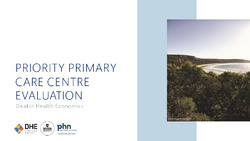Please use this identifier to cite or link to this item:
http://hdl.handle.net/11054/2329| Title: | Evaluation of the Priority Primary Care Centre program in the western region of Victoria, Australia. |
| Author: | Frith, M. Randall, S. Savira, F. Swann, J. White, N. Giddy, A. McLean, Kirsty Peeters, A. Robinson, S. |
| Issue Date: | 2023 |
| Conference Name: | Western Alliance 2023 Symposium. |
| Conference Date: | November 21-22 |
| Conference Place: | Warrnambool, Victoria |
| Abstract: | Background/aim: The Victorian State Government has established Priority Primary Care Centers (PPCCs) to reduce the demand on Emergency Departments (EDs). PPCCs are general practitioner led, free of charge services that aim to provide care for conditions that require urgent attention, but do not require the high-acuity care of an ED. This study aims to evaluate the implementation and impact of the PPCC on ED demand across three sites within the Western region of Victoria. Population/setting: Three PPCC sites in Western Victoria: Ballarat, Geelong and Warrnambool. Methods: This is an observational mixed methods study. The quantitative component involves analysis of de[1]identified administrative data, comprising PPCC clinical records and ED presentation records. An interrupted time series analysis will be employed to assess the effect of PPCC on ED demand. Qualitative data collection involves semi-structured interviews to understand the experiences of PPCC patients, clinical staff, managerial and administrative staff and ED clinical staff. A documentary analysis of material relating to the implementation of the PPCC will also be conducted. Implementation science frameworks has been integrated within the study design. Results/findings: Preliminary analysis of PPCC clinical records from 28 October 2022 until 1 July 2023 indicated 12,961 unique attendances, mostly in Ballarat PPCC (68%). The mean number of visits during this period was 54 per day. The greatest patient load was those younger than 15 years old (32%), and with slightly greater proportion of female patients (53%) than males. Most patients reside in regional centres (64%), followed by metropolitan regions (excluding Greater Melbourne) (22%) and small rural towns (9%). In terms of socioeconomic backgrounds, most patients live in areas classified as Quintile 3 (40%), Quintile 4 (25%) and Quintile 1 (19%). After attending the PPCC, 13% of patients were referred to general practice and 2% to the hospital/emergency department, while 80% of attendances were fully resolved. Qualitative data collection is currently underway, and synthesis of emerging themes will commence shortly. Conclusion: The PPCC has reached a broad range of patients with various demographic and socioeconomic backgrounds across the region. Translational impact/implications for future practice: Most attendances were resolved in the clinic, suggesting the PPCC is filling a gap of unmet need for urgent but low-acuity care. |
| URI: | http://hdl.handle.net/11054/2329 |
| Internal ID Number: | 02345 |
| Health Subject: | EMERGENCY DEPARTMENT HEALTH SERVICES ADMINISTRATION & MANAGEMENT GENERAL MEDICINE PUBLIC HOSPITALS REGIONAL ELECTRONIC HEALTH RECORDS |
| Type: | Conference Presentation |
| Appears in Collections: | Research Output |
Files in This Item:
| File | Description | Size | Format | |
|---|---|---|---|---|
| Madison Frith_PPCC_Western Alliance Symposium Presentation (1).pdf | 2.97 MB | Adobe PDF |  View/Open |
Items in DSpace are protected by copyright, with all rights reserved, unless otherwise indicated.
